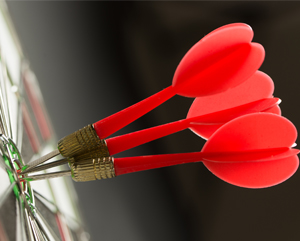Is the marketing funnel still relevant in the digital age?
Since the onset of digitalisation, marketers have had to adapt and sometimes reassess their marketing strategies to fit with the demands of the new marketplace which surrounds them. This shift has also brought about huge changes in the way that consumers buy and research goods and so keeping up with developments has required regular insight generation and a remapping of the customer journey. In this blog we’re exploring the marketing funnel and seeing how to stay relevant for digital consumers.
The traditional marketing funnel
In years past, agencies and in-house teams alike relied heavily on the marketing funnel to inform their strategy. You’ve probably heard it called a sales funnel or purchase funnel. Marketing and sales teams use it to map the stages that a customer passes through in order to make a purchase.
Although there are some deviations in how many stages are involved, according to Business2Community the traditional marketing funnel has three stages: awareness, consideration and decision.
Awareness: According to the article, this ‘is the point in which your lead is trying to solve a problem, and they’ve come across the content you’ve created in their quest for a solution.’ In the digital era this is most commonly done online and even when the customer intends to buy in a bricks and mortar store, the research phase rarely moves outside the digital dimension.
Consideration: Once you have attracted the attention of the consumer, it is argued that they continue on to a period of consideration. This can be the most dangerous and competitive stage of the funnel, with offerings from other brands liable to steal your lead or a lack of information quick to prove an obstacle to confirming a purchase. For Business2Community ‘this is where you nurture your leads, and try to build trust between your brand and your audience’ to tackle these issues.
Decision: Last in the traditional marketing funnel is the decision phase. It’s the ultimate end goal of your brand if you are to make a sale. Even at this stage conversion is not a guarantee. You need ‘the right content with the right call-to-action’ to turn the lead into a customer.
The collapse of the marketing funnel?
Only a few weeks ago Facebook’s Sheryl Sandberg, arguably one of the most influential commentators and thinkers of the moment, suggested that perhaps the trusty marketing funnel is no longer relevant in our digital age.
Reporting on her speech at ad-tech conference Dmexco in Germany, Marketing Week quoted Sandberg as saying:
‘The marketing funnel itself is collapsing. It used to take time to go from research to discovery to awareness all the way to a purchase. But now you have digital and mobile that is happening faster than ever.’
As such, brand communication has never been more important. Sandberg suggests that in order for brands to continue to grow they must focus on three areas. ‘The first is “focusing on your brand mission”, the second “building communities” and the third “engaging that community” for the long-term,’ she believes. Sandberg sees it as integral that brands work towards fulfilling these criteria. Doing so allows them to adapt to changes in the traditional marketing funnel.
No longer linear, and as Sandberg pointed out happening at ever-increasing speeds across multiple platforms, the marketing funnel has increased in the number of stages it involves. There are also an increased number of potential obstacles that stand in the way of conversion. As such, marketers need to take clear steps to adapt this model to remain relevant in the digital age.
What steps can marketers take to retain relevance?
The marketing funnel is constantly evolving, but this does not mean that it should be dismissed out of hand. Here are three steps that marketers can take to adapt their funnel for digital consumers:
1. Build on what you have
MarTech Today argues that ‘improving what’s working is much more efficient than constantly starting from scratch. ’ They suggest adapting the stages of the marketing funnel to include stages like “acquisition,” “activation” and “retention”. These overtake the old steps of “awareness” and “decision”. The article also suggests that the lines between these stages are becoming increasingly blurred. You should instead focus on what the customer needs and wants at various points in their journey. This is a far more productive way to address the brand-customer relationship. Stop worrying about which exact stage they are at in the funnel!
2. Map a core pathway
Inc.com also builds on this outlook, arguing that in order to better adapt the marketing funnel to the increasingly non-linear customer journey, mapping out a core pathway can help you make sense of the how the funnel can be used. Inc.com suggests you should be asking the question:
‘How do you plan to walk your prospect through the funnel so that logically and emotionally you have the best odds of getting the highest number of them to your desired end result?’
Physically map out this core pathway with all the steps and sub-steps you need to reach your end goal. You’ll then find it is easier to see conversion points and allow for divergences from this presumed route to sale. Inc.com argues that this allows you to map both logical and emotional decisions. Then, you can simplify the process by eradicating the unnecessary steps and build a primary funnel that is right for you. It’ll be profitable and efficient from the point of view of your unique business needs.
3. Focus on re-targeting, re-engaging and re-marketing
The potential for leads to be lost along the way is arguably far higher in the digital age. But, by having a strategy in place to tackle this challenge, marketers can reintegrate leads back into the marketing funnel.
An article by The Huffington Post suggests that by using retargeted display ads, the kind ‘which are shown to users on other sites on the web after they have left your website,’ is just one way of bringing people back into the fold. By using these adverts to ‘highlight your best content, feature a promotion, or incentivise an action,’ marketers can focus on re-engagement with their brand. This approach also allows better management of the newer phases of the funnel. Retention and reactivation require a more nuanced approach than the traditional funnel allows.
Far from being dead in the water, the traditional marketing funnel needs an update. We must rethink and re-strategise to keep pace with the demands of digitally-savvy consumers. The funnel is no longer be linear. But, it still offers multiple insights and uses that marketers would do well not to dismiss.
Want to talk about upgrading your brand and creating your useful digital marketing funnel? Get in touch with the friendly experts at Think OTB.




